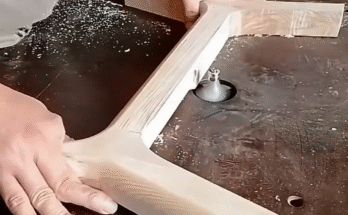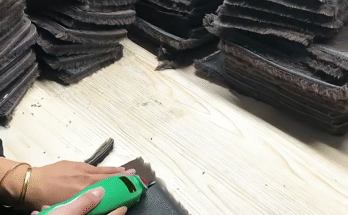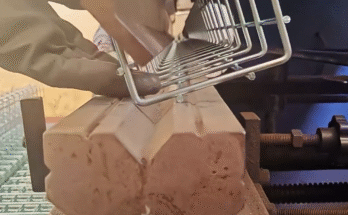Water knife (or water jet) cutting is an advanced and highly precise method for shaping ceramic materials. Unlike traditional cutting methods that can cause chipping or cracking, water jet cutting offers a clean, heat-free process, making it ideal for delicate and intricate ceramic designs. This guide will walk you through the essential steps involved in transforming raw ceramic into finely cut pieces.
Step 1: Design and Digital Preparation 💻
The journey begins with meticulous planning and digital translation of the desired ceramic shape.
Conceptualize the Design: Create the design for the ceramic piece using Computer-Aided Design (CAD) software. This design will define all the contours, holes, and intricate details to be cut. Nesting for Efficiency: If multiple pieces are to be cut from a single ceramic sheet, arrange them digitally (nesting) to maximize material utilization and minimize waste. CAM Programming: Convert the CAD design into machine-readable instructions using Computer-Aided Manufacturing (CAM) software. This program precisely controls the water jet’s path, speed, and pressure. Simulation (Optional): Many CAM systems offer simulation features to visualize the cutting process and identify any potential issues before actual cutting commences. Step 2: Ceramic Material Preparation and Loading 🏗️
Preparing the ceramic for the cutting process is crucial for a successful outcome.
Material Selection: Choose the appropriate type of ceramic (e.g., porcelain, stoneware, terracotta, technical ceramics) based on the application and desired properties. Ensure the ceramic sheet is clean and free of any surface imperfections. Cleaning: Thoroughly clean the ceramic surface to remove any dust, debris, oils, or contaminants that could affect the cutting quality or clog the water jet system. Secure Placement: Carefully position and secure the ceramic sheet onto the water jet cutting table. The table typically has a slatted design or a water tank beneath to dissipate the energy of the water jet. Proper clamping or weighting prevents movement during cutting, which is vital for maintaining accuracy. Step 3: Water Jet Machine Setup ⚙️
Configuring the water jet system for optimal ceramic cutting.
Water Supply: Ensure a clean, demineralized water supply is connected to the intensifier pump. Water purity is essential to prevent mineral buildup and extend the life of the nozzle. Abrasive Loading: For cutting ceramics, an abrasive material (typically garnet) is essential. Load the selected abrasive into the hopper. The type and grit size of the abrasive will influence the cut quality and speed. Nozzle Selection: Choose the appropriate cutting nozzle (orifice and mixing tube) size. The orifice diameter controls the water stream’s focus, while the mixing tube combines the water and abrasive. Pressure Setting: Set the water pressure to the recommended level for ceramic cutting, usually ranging from 30,000 to 60,000 PSI (pounds per square inch). Higher pressures generally lead to faster cuts and finer edges. Abrasive Flow Rate: Adjust the abrasive flow rate. An optimal flow rate ensures efficient cutting without excessive abrasive consumption or wear on components. Step 4: High-Pressure Water Generation and Abrasive Mixing 💧
The core mechanism of the water jet cutting process.
Intensifier Pump: A high-pressure intensifier pump takes the incoming water and boosts its pressure to extreme levels. This is typically achieved through a hydraulic system that drives plungers to compress the water. Water Delivery: The super-pressurized water is delivered through high-pressure lines to the cutting head. Orifice: The water passes through a tiny jewel orifice (often sapphire or diamond) within the cutting head, transforming the high-pressure water into an incredibly thin, high-velocity stream. Mixing Chamber: For abrasive cutting, this high-velocity water stream then enters a mixing chamber. The vacuum created here draws in the abrasive garnet from the hopper. Mixing Tube: The water and abrasive particles are thoroughly mixed within a durable mixing tube (often made of tungsten carbide) to form a coherent, highly erosive cutting stream. Step 5: The Cutting Process ✂️
The actual shaping of the ceramic material.
Initiate Cut: The water jet cutting head, precisely guided by the CAM program, moves to the starting point of the cut. The high-pressure abrasive water jet is then activated. Following the Path: The cutting head accurately follows the programmed path, with the abrasive jet eroding the ceramic material away. The cutting speed is carefully controlled to achieve the desired edge quality and minimize any taper. Pierce Point: For internal cuts or holes, the jet will “pierce” the ceramic, creating a starting hole before continuing the cut. This piercing process is often slower to prevent material cracking or delamination, especially with brittle ceramics. Cold Cutting: A significant advantage of water jet cutting is that it’s a cold process. This means it generates very little heat, preventing thermal distortion, micro-cracking, or changes in the ceramic’s material properties that can occur with heat-based cutting methods. Step 6: Post-Cutting and Finishing 🧼
After the cutting is complete, the ceramic pieces are prepared for their final use.
Part Removal: Once the cutting is finished, the cut ceramic pieces are carefully removed from the cutting table. Rinsing: The cut parts are rinsed with clean water to remove any remaining abrasive particles or cutting residue. Drying: The ceramic pieces are thoroughly dried. Edge Finishing (Optional): While water jet cuts are generally clean, some applications might require additional edge finishing, such as light sanding or polishing, to achieve a perfectly smooth or desired aesthetic. Quality Inspection: The cut ceramic pieces undergo a thorough quality inspection to check for dimensional accuracy, edge quality, and any defects. The Ceramic Advantage: Precision and Versatility 🌟
Water knife cutting is an invaluable technique for ceramic fabrication, offering unparalleled precision, the ability to create intricate designs, and a cold cutting process that preserves the material’s integrity. Its versatility makes it suitable for everything from artistic tiles to high-performance industrial ceramic components.



